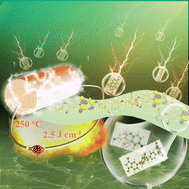Intrinsic-designed polyimide dielectric materials with large energy storage density and discharge efficiency at harsh ultra-high temperatures†
Abstract
Polymer dielectric materials with excellent temperature stability are urgently needed for the ever-increasing energy storage requirements under harsh high-temperature conditions. In this work, a novel diamine monomer (bis(2-cyano-4-aminophenyl)amine) was successfully synthesized to prepare a series of cyano-containing polyimides (CPI-1–3), which possessed excellent dielectric properties and high thermostability. The maximum dielectric permittivity was up to 5.5 at 102 Hz for CPI-3, being 2.5 times higher than that of commercially used BOPP. In comparison, the CPI-1 exhibited an outstanding breakdown strength of 433 MV m−1 and a high energy density of 2.5 J cm−3 even at 250 °C, which was the highest value reported under the same conditions. The synthesized CPIs through such an intrinsic approach are potential candidate materials for energy storage and even other applications under simultaneously harsh electrical and thermal conditions.



 Please wait while we load your content...
Please wait while we load your content...